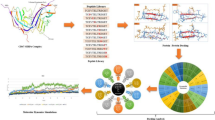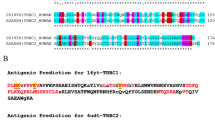Abstract
Cluster of differentiation 147 (CD147) is an attractive target for anticancer therapy since it is pivotal in developing and progressing several of malignant tumors in the context of its high expression levels. Although anti-CD147 antibodies by different laboratories are designed for the Ig-like domains of CD147, there is a demand to provide priority among these anti-CD147 antibodies for developing of therapeutic anti-CD147 antibody before experimental validations. This study uses molecular docking and dynamic simulation techniques to compare the binding modes and affinities of nine antibody models against the Ig-like domains of CD147. After obtaining the model antibodies by homology modeling via Robetta, we predicted the CDRs of nine antibodies and the epitopes of CD147 to reach more accurate results for antigen affinity in molecular docking. Next, from HADDOCK 2.4., we meticulously handpicked the most superior model clusters (Z-Score: − 2.5 to − 1.2) and identified that meplazumab had higher affinities according to the success rate as the percentage of a scoring scale. We achieved stable simulations of CD147-antibody interaction. Our outcomes hold hypothetical importance for further experimental cancer research on the design and development of the relevant model antibodies.



Similar content being viewed by others
Data availability
Data related to this paper are ready to share upon reasonable demand.
References
Bray F, Ferlay J, Soerjomataram I et al (2018) Global cancer statistics 2018: GLOBOCAN estimates of incidence and mortality worldwide for 36 cancers in 185 countries. CA Cancer J Clin 68:394–424. https://doi.org/10.3322/caac.21492
Scott AM, Wolchok JD, Old LJ (2012) Antibody cancer therapy. Nat Stud Cancer 12:278–287. https://doi.org/10.1038/nrc3236
Consortium U (2019) UniProt: a worldwide hub of protein knowledge. Nucleic Acids Res 47:D506–D515. https://doi.org/10.1093/nar/gky1049
Riethdorf S, Reimers N, Assmann V et al (2006) High incidence of EMMPRIN expression in human tumors. Int J cancer 119:1800–1810. https://doi.org/10.1002/ijc.22062
Baba M, Inoue M, Itoh K, Nishizawa Y (2008) Blocking CD147 induces cell death in cancer cells through impairment of glycolytic energy metabolism. Biochem Biophys Res Commun 374:111–116. https://doi.org/10.1016/j.bbrc.2008.06.122
Cui H-Y, Guo T, Wang S-J et al (2012) Dimerization is essential for HAb18G/CD147 promoting tumor invasion via MAPK pathway. Biochem Biophys Res Commun 419:517–522. https://doi.org/10.1016/j.bbrc.2012.02.049
Landras A, de Moura C, Jouenne F et al (2019) CD147 is a promising target of tumor progression and a prognostic biomarker. Cancers (Basel) 11:1803. https://doi.org/10.3390/cancers11111803
Maeda K, Kosugi T, Sato W et al (2015) CD147/basigin limits lupus nephritis and Th17 cell differentiation in mice by inhibiting the interleukin-6/STAT-3 pathway. Arthritis Rheumatol 67:2185–2195. https://doi.org/10.1002/art.39155
Somno A, Anuchapreeda S, Chruewkamlow N et al (2016) Involvement of CD147 on multidrug resistance through the regulation of P-glycoprotein expression in K562/ADR leukemic cell line. Leuk Res reports 6:33–38. https://doi.org/10.1016/j.lrr.2016.08.001
Krawczyk K, Buchanan A, Marcatili P (2021) Data mining patented antibody sequences. MAbs. https://doi.org/10.1080/19420862.2021.1892366
Terstappen GC, Reggiani A (2001) In silico research in drug discovery. Trends Pharmacol Sci 22:23–26. https://doi.org/10.1016/S0165-6147(00)01584-4
Song Y, DiMaio F, Wang RY-R et al (2013) High-resolution comparative modeling with RosettaCM. Structure 21:1735–1742. https://doi.org/10.1016/j.str.2013.08.005
Raman S, Vernon R, Thompson J et al (2009) Structure prediction for CASP8 with all-atom refinement using Rosetta. Proteins Struct Funct Bioinforma 77:89–99. https://doi.org/10.1002/prot.22540
Peña-García J, Pérez-Sánchez H (2020) Assessment of interaction of human OCT 1–3 proteins and metformin using silico analyses. Acta Chim Slov. https://doi.org/10.17344/acsi.2020.6108
Waterhouse A, Bertoni M, Bienert S et al (2018) SWISS-MODEL: homology modelling of protein structures and complexes. Nucleic Acids Res 46:W296–W303. https://doi.org/10.1093/nar/gky427
McGuffin LJ, Aldowsari FM, Alharbi SM et al (2021) ModFOLD8: accurate global and local quality estimates for 3D protein models. Nucleic Acids Res 49:W425–W430. https://doi.org/10.1093/nar/gkab321
WIPO - Search International and National Patent Collections.
Pettersen EF, Goddard TD, Huang CC et al (2004) UCSF Chimera—A visualization system for exploratory research and analysis. J Comput Chem 25:1605–1612. https://doi.org/10.1002/jcc.20084
Van Zundert GCP, Rodrigues J, Trellet M et al (2016) The HADDOCK2. 2 web server: user-friendly integrative modeling of biomolecular complexes. J Mol Biol 428:720–725. https://doi.org/10.1016/j.jmb.2015.09.014
De Vries SJ, Van Dijk M, Bonvin AMJJ (2010) The HADDOCK web server for data-driven biomolecular docking. Nat Protoc 5:883. https://doi.org/10.1038/nprot.2010.32
Dunbar J, Deane CM (2016) ANARCI: antigen receptor numbering and receptor classification. Bioinformatics 32:298–300. https://doi.org/10.1093/bioinformatics/btv552
Dunbar J, Krawczyk K, Leem J et al (2016) SAbPred: a structure-based antibody prediction server. Nucleic Acids Res 44:W474–W478. https://doi.org/10.1093/nar/gkw361
Schrödinger, LLC (2015) The {PyMOL} Molecular Graphics System, Version~1.8.
Release S, others (2017) 3: Desmond molecular dynamics system, DE Shaw research, New York, NY, 2017. Maest Interoperability Tools, Schrödinger, New York, NY.
Nosé S (1984) A molecular dynamics method for simulations in the canonical ensemble. Mol Phys 52:255–268. https://doi.org/10.1080/00268978400101201
Hoover WG (1985) Canonical dynamics: equilibrium phase-space distributions. Phys Rev A 31:1695. https://doi.org/10.1103/PhysRevA.31.1695
Martyna GJ, Tobias DJ, Klein ML (1994) Constant pressure molecular dynamics algorithms. J Chem Phys 101:4177–4189. https://doi.org/10.1063/1.467468
Roos K, Wu C, Damm W et al (2019) OPLS3e: extending force field coverage for drug-like small molecules. J Chem Theory Comput 15:1863–1874. https://doi.org/10.1021/acs.jctc.8b01026
Xiang Z (2006) Advances in homology protein structure modeling. Curr Protein Pept Sci 7:217–227. https://doi.org/10.2174/138920306777452312
Hildebrand PW, Rose AS, Tiemann JKS (2019) Bringing molecular dynamics simulation data into view. Trends Biochem Sci 44:902–913. https://doi.org/10.1016/j.tibs.2019.06.004
Helal MA, Shouman S, Abdelwaly A et al (2020) Molecular basis of the potential interaction of SARS-CoV-2 spike protein to CD147 in COVID-19 associated-lymphopenia. J Biomol Struct Dyn. https://doi.org/10.1016/j.snb.2022.132427
Leem J, Dunbar J, Georges G et al (2016) A BodyBuilder: automated antibody structure prediction with data–driven accuracy estimation. MAbs. https://doi.org/10.1080/19420862.2016.1205773
Lepore R, Olimpieri PP, Messih MA, Tramontano A (2017) PIGSPro: prediction of immunoGlobulin structures v2. Nucleic Acids Res 45:W17–W23. https://doi.org/10.1093/nar/gkx334
Weitzner BD, Jeliazkov JR, Lyskov S et al (2017) Modeling and docking of antibody structures with Rosetta. Nat Protoc 12:401. https://doi.org/10.1038/nprot.2016.180
Pedotti M, Simonelli L, Livoti E, Varani L (2011) Computational docking of antibody-antigen complexes, opportunities and pitfalls illustrated by influenza hemagglutinin. Int J Mol Sci 12:226–251. https://doi.org/10.3390/ijms12010226
Vajda S (2005) Classification of protein complexes based on docking difficulty. Proteins Struct Funct Bioinforma 60:176–180. https://doi.org/10.1002/prot.20554
Sela-Culang I, Kunik V, Ofran Y (2013) The structural basis of antibody-antigen recognition. Front Immunol 4:302. https://doi.org/10.3389/fimmu.2013.00302
Ambrosetti F, Jiménez-García B, Roel-Touris J, Bonvin AMJJ (2020) Modeling antibody-antigen complexes by information-driven docking. Structure 28:119–129. https://doi.org/10.1016/j.str.2019.10.011
Yu X-L, Hu T, Du J-M et al (2008) Crystal structure of HAb18G/CD147: implications for immunoglobulin superfamily homophilic adhesion. J Biol Chem 283:18056–18065. https://doi.org/10.1074/jbc.M802694200
Wright KE, Hjerrild KA, Bartlett J et al (2014) Structure of malaria invasion protein RH5 with erythrocyte basigin and blocking antibodies. Nature 515:427–430. https://doi.org/10.1038/nature13715
Kumar D, Vetrivel U, Parameswaran S et al (2019) Structural insights on druggable hotspots in CD147: a bull’s eye view. Life Sci 224:76–87. https://doi.org/10.1016/j.lfs.2019.03.044
Fu ZG, Wang L, Cui HY, Peng JL, Wang SJ et al (2016) A novel small-molecule compound targeting CD147 inhibits the motility and invasion of hepatocellular carcinoma cells. Oncotarget 7(8):9429. https://doi.org/10.18632/oncotarget.6990
Li W, Wang D, Ge Y, Zhang L et al (2020) Discovery and biological evaluation of CD147 N-Glycan inhibitors: a new direction in the treatment of tumor metastasis. Molecules 26(1):33. https://doi.org/10.3390/molecules26010033
Chen L, Fan T, Wang M, Zhu CY et al (2024) Myricetin, a natural inhibitor of CD147, increases sensitivity of cisplatin in ovarian cancer. Expert Opin Ther Targets. https://doi.org/10.1080/14728222.2024.2306345
Acknowledgements
This research was partially supported by the supercomputing infrastructure of Poznan Supercomputing Center, and by the e-infrastructure program of the Research Council of Norway, and the supercomputer center of UiT—the Arctic University of Norway. The authors also thankfully acknowledge the computer resources and the technical support provided by the Plataforma Andaluza de Bioinforma ́tica of the University of Ma ́laga. Powered@NLHPC: This research was partially supported by the supercomputing infrastructure of the NLHPC (ECM-02).
Funding
This work has been supported to H.P.-S. by the Fundación Séneca del Centro de Coordinación de la Investigación de la Región de Murcia (under Project 20988/PI/18) and by a grant from Ministerio de Economía y Competitividad de Espan ̃a (CTQ2017-87974-R). M. C.-B. is a predoctoral employed to the training of research staff financed by the Plan Propio de Investigación de la UCAM.
Author information
Authors and Affiliations
Contributions
All authors hypothesized the subject. Besli, Bulut and Onaran performed the concept design and writing processes. Data collection and edited of the article were conducted by CARMENA-BARGUEÑO and Besli. PÉREZ-SÁNCHEZ, CARMENA-BARGUEÑO and Besli evaluated the results.
Corresponding author
Ethics declarations
Conflict of interest
The authors declare no competing interests.
Ethical approval
Not applicable.
Consent to publish
Yes.
Additional information
Publisher's Note
Springer Nature remains neutral with regard to jurisdictional claims in published maps and institutional affiliations.
Supplementary Information
Below is the link to the electronic supplementary material.
Rights and permissions
Springer Nature or its licensor (e.g. a society or other partner) holds exclusive rights to this article under a publishing agreement with the author(s) or other rightsholder(s); author self-archiving of the accepted manuscript version of this article is solely governed by the terms of such publishing agreement and applicable law.
About this article
Cite this article
Besli, N., Bulut, H.İ., Onaran, İ. et al. Comparative assessment of different anti-CD147/Basigin 2 antibodies as a potential therapeutic anticancer target by molecular modeling and dynamic simulation. Mol Divers (2024). https://doi.org/10.1007/s11030-024-10832-w
Received:
Accepted:
Published:
DOI: https://doi.org/10.1007/s11030-024-10832-w




